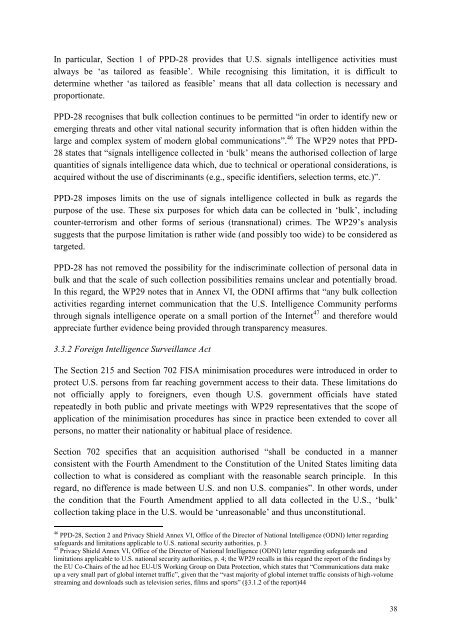ARTICLE 29 DATA PROTECTION WORKING PARTY
1SANK0H
1SANK0H
Create successful ePaper yourself
Turn your PDF publications into a flip-book with our unique Google optimized e-Paper software.
In particular, Section 1 of PPD-28 provides that U.S. signals intelligence activities must<br />
always be ‘as tailored as feasible’. While recognising this limitation, it is difficult to<br />
determine whether ‘as tailored as feasible’ means that all data collection is necessary and<br />
proportionate.<br />
PPD-28 recognises that bulk collection continues to be permitted “in order to identify new or<br />
emerging threats and other vital national security information that is often hidden within the<br />
large and complex system of modern global communications”. 46 The WP<strong>29</strong> notes that PPD-<br />
28 states that “signals intelligence collected in ‘bulk’ means the authorised collection of large<br />
quantities of signals intelligence data which, due to technical or operational considerations, is<br />
acquired without the use of discriminants (e.g., specific identifiers, selection terms, etc.)”.<br />
PPD-28 imposes limits on the use of signals intelligence collected in bulk as regards the<br />
purpose of the use. These six purposes for which data can be collected in ‘bulk’, including<br />
counter-terrorism and other forms of serious (transnational) crimes. The WP<strong>29</strong>’s analysis<br />
suggests that the purpose limitation is rather wide (and possibly too wide) to be considered as<br />
targeted.<br />
PPD-28 has not removed the possibility for the indiscriminate collection of personal data in<br />
bulk and that the scale of such collection possibilities remains unclear and potentially broad.<br />
In this regard, the WP<strong>29</strong> notes that in Annex VI, the ODNI affirms that “any bulk collection<br />
activities regarding internet communication that the U.S. Intelligence Community performs<br />
through signals intelligence operate on a small portion of the Internet 47 and therefore would<br />
appreciate further evidence being provided through transparency measures.<br />
3.3.2 Foreign Intelligence Surveillance Act<br />
The Section 215 and Section 702 FISA minimisation procedures were introduced in order to<br />
protect U.S. persons from far reaching government access to their data. These limitations do<br />
not officially apply to foreigners, even though U.S. government officials have stated<br />
repeatedly in both public and private meetings with WP<strong>29</strong> representatives that the scope of<br />
application of the minimisation procedures has since in practice been extended to cover all<br />
persons, no matter their nationality or habitual place of residence.<br />
Section 702 specifies that an acquisition authorised “shall be conducted in a manner<br />
consistent with the Fourth Amendment to the Constitution of the United States limiting data<br />
collection to what is considered as compliant with the reasonable search principle. In this<br />
regard, no difference is made between U.S. and non U.S. companies”. In other words, under<br />
the condition that the Fourth Amendment applied to all data collected in the U.S., ‘bulk’<br />
collection taking place in the U.S. would be ‘unreasonable’ and thus unconstitutional.<br />
46 PPD-28, Section 2 and Privacy Shield Annex VI, Office of the Director of National Intelligence (ODNI) letter regarding<br />
safeguards and limitations applicable to U.S. national security authorities, p. 3<br />
47 Privacy Shield Annex VI, Office of the Director of National Intelligence (ODNI) letter regarding safeguards and<br />
limitations applicable to U.S. national security authorities, p. 4; the WP<strong>29</strong> recalls in this regard the report of the findings by<br />
the EU Co-Chairs of the ad hoc EU-US Working Group on Data Protection, which states that “Communications data make<br />
up a very small part of global internet traffic”, given that the “vast majority of global internet traffic consists of high-volume<br />
streaming and downloads such as television series, films and sports” (§3.1.2 of the report)44<br />
38


